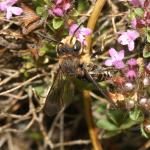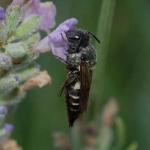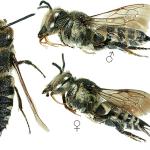Coelioxys trigonus SCHRANK 1793; Coelioxys vectis CURTIS 1831; Coelioxys punctata LEPELETIER 1841; Coelioxys temporalis NYLANDER 1848
Widespread in southern England from the south coast north to Somerset and Norfolk. In Wales known from Glamorgan, Pembroke, Carmarthen and Merioneth. According to Felton (in Hawksworth, 1974), it may be a relatively recent arrival in Wales, having been first found there, in Glamorgan, in 1972. The first record of the species from Kent was in 1952 (Leclerq, 1968). Also recorded from the Channel Islands. Although the host of this cleptoparasite occurs in southern Ireland, there are no records of C. conoidea from that country. Unlike most British Coelioxys, this species is occasionally locally common where found, especially on the coast. The species occurs throughout much of Europe and the Middle East, from Fennoscandia east to at least Iran and Afghanistan.
This bee is not regarded as being scarce or threatened.
Coastal dunes and landslips, inland commons and heaths and, more rarely, chalk grassland.
Univoltine; mid June to late August.
A cleptoparasite of the leafcutter bee Megachile maritima (Smith 1876; Gardner 1901; Chambers 1949).
Sea-lavender (Limonium species), common mallow (Malva sylvestris), sea rocket (Cakile maritima), bramble (Rubus fruticosus agg.), sea-holly (Eryngium maritimum), sea bindweed (Calystegia soldanella), thyme (Thymus species), spear thistle (Cirsium vulgare), knapweeds (Centaurea species) and ragwort (Senecio sp.).
No information available.
Profile written:
Proofed: January 2012




